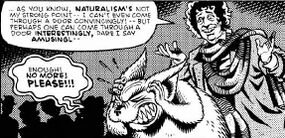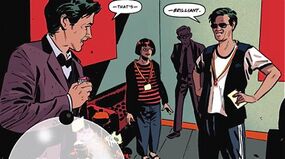Meta-fiction universe
Check the behind the scenes section, the revision history and discussion page for additional comments on this article's title.
- You may be looking for the Doctor Who science fiction series from the Doctor's main universe.
In a parallel universe, the Doctor's life and adventures were fictional stories presented in a science fiction series called Doctor Who.
Tom Baker, (COMIC: TV Action!, The Girl Who Loved Doctor Who) Peter Davison, Matt Smith, Elisabeth Sladen, Karen Gillan, Arthur Darvill, and Jenna Coleman were all actors who starred in the series.
Episodes of Doctor Who included The Android Invasion, The Twin Dilemma, The Doctor, the Widow and the Wardrobe, Asylum of the Daleks, Dinosaurs on a Spaceship, A Town Called Mercy, The Power of Three, The Angels Take Manhattan, The Snowmen, The Bells of Saint John, The Rings of Akhaten, Cold War, Hide, Journey to the Centre of the TARDIS, The Crimson Horror, Nightmare in Silver and The Name of the Doctor. (COMIC: The Girl Who Loved Doctor Who)
In one version of the meta-fiction universe, Doctor Who was prematurely cancelled and Juliet Bravo gained a significant fanbase instead. (AUDIO: Deadline, All Our Christmases)
History
20th century
Terry Nation created the Daleks in 1963a and in 1966, Kit Pedler and Gerry Davis created the Cybermen. Bob Baker and Dave Martin created K-9 in 1977. (COMIC: The Girl Who Loved Doctor Who)
On 12 October 1979, the Eighth Doctor and Izzy Sinclair visited the meta-fiction universe. At that universe's BBC Television Centre, the actor Tom Baker (who played the Fourth Doctor) fended off Beep the Meep by infuriating him with his endless rambling. The Doctor realised the truth when he found himself with the first issue of Doctor Who Weekly. (COMIC: TV Action!)
21st century
In 2007, an annual was released with the Tenth Doctor on the cover.
In 2012, the seventh series of Doctor Who began. A new version of the Doctor Who logo was created in the same year. In 2013, the seventh series continued and ended. A DVD was released including the complete series. The Eleventh Doctor visited the universe in this year and spent some time with Ally. He met both Matt Smith and Steven. As this incarnation looked exactly like Matt Smith, the Doctor was mistaken for him at a convention and gave out autographs to fans. After defeating an actual Cyberman from his native univere, the Doctor he returned home to it. (COMIC: The Girl Who Loved Doctor Who)
Alternate timeline
In one timeline, the Bureau of Time Travel permitted the use of time travel as a means to correct several production mistakes made in the series. The first change made was preventing the hand of one of the production team from being caught on camera while they were holding down a cushion on the villain's throne during "a really good episode". The alteration of the series' history escalated until a few lines were added to the first episode concerning the main character's background. This final change was too much.
In the new history, the show did not last long. Viewers thought it took itself too seriously. (PROSE: All Our Christmases) Juliet Bravo replaced Doctor Who in history. (PROSE: All Our Christmases, AUDIO: Deadline) Without the show to inspire actual time travel, the Bureau of Time Travel was never established.
For a while, Richard, one of the time travellers who changed history, remembered the previous history. The First Doctor visited Richard and listened to him tell the story of how the show was erased from history. Richard soon assimilated into his place in the new history and happily returned to his job writing for the Juliet Bravo magazine. (PROSE: All Our Christmases)
In his later life, Martin Bannister lamented that Doctor Who never became a success. He was interviewed for his work on Juliet Bravo, but nobody was interested in Doctor Who. Martin had demented visions of characters and settings from Doctor Who which culminated in his suicide. (AUDIO: Deadline)


